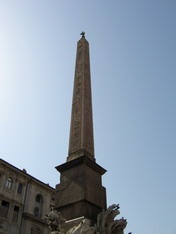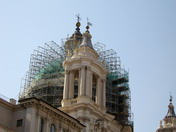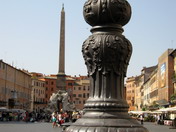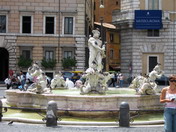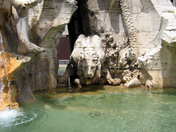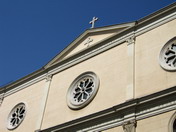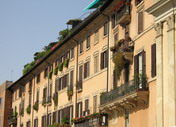Piazza Navona Rome
Piazza Navona in Rome is the meeting place for both the tourists and the people of Rome. I'ts a perfect place to relax on with a coffee or a bite to eat and you can just study the crowd. In the summer at the evening people gather here to socialize and also eat dinner at the restaurants at Piazza Navona or nearby.
Piazza Navona was originally built for racing with a special type of wartanks, and the loser risked being executed. Today, Piazza Navona, is a market place with restaurants and cafés, and alsoartist that sells painting or make a portrait of you.
As a tourist you can here find the usual range of souvenirs.
The architecture at the square and the beautiful fountains make it well worth a visit. The restaurants are quite expensive thou. If you want to eat cheaper (but with even better quality) test the streets nearby. There are plenty of them on the west side of the Square.
(Click the pictures from Rome for bigger versions)
Piazza Navona is a generous square where fountains, tourists, street vendors and restaurants are crowded. Left you se a glimpse of the church Sant'Agnese in Agone.
In a big city like Rome there always ongoing renovations here and there. The scaffolding on the buildings are normally not so fun, but here I found that they were actually a little bit decorative.
Map of Piazza Navona »
Facts about Piazza Navona:
Piazza Navona in Rome was completed in 86 AD and was built by the emperor Domitian as an arena for chariot racing. The loser risked his life. Today it is a meeting place and with a market and restaurants. In the evenings there is a vibrant nightlife.
In the middle of the square you find Fontana dei Quattro Fiumi, the Four Rivers fountain that is a work of Giovanni Lorenzo Bernini and it was unveiled in 1651. It was commissioned by Pope Innocentius X. The fountain consists of a cliff crowned by an obelisk which formerly stood at the Circus Maximus on the Via Appia.
The four rivers are the Danube, the Rio de la Plata, Ganges and Nile. River Gods in the fountain represent the continents where the rivers crossed, and the continents they knew at the time: Europe, Africa, Asia and America.
Bernini had his students sculpt the River Gods but personally designed the rock and some smaller figures. The Fountain also contains seven animals that have been linked to the different rivers.
In the northern part of the square the statue Fontana di Nettuno from 1878 stands, showing the sea god Neptune as he struggles with a sea monster.
In the opposite southern part lies Fontana del Moro, which was created by Giacomo della Porta but later was redesigned by Bernini who added the central figure "il Moro".
The Church Sant'Agnese located at the square was designed by Bernini's rival, Francesco Borromino. Originally the church had its entrance from the back as seen from the square but was later changed. Girolamo Rainaldi was the one who started the work on the church, but he was replaced after a year by Borromino which changed almost everything. But in 1655 Pope Innocent X died and Borromino dropped lost his support, Prince Camillo Pamphili replaced him with Rainaldi who completed the church's façade in 1666.
At the square is also the Palazzo Pamphili, the Brazilian embassy, formerly a palace. It was designed by Girolamo Rainaldi and completed in 1650.
If you visit Rome in the winter before Christmas you can buy Christmas decorations in the market.


